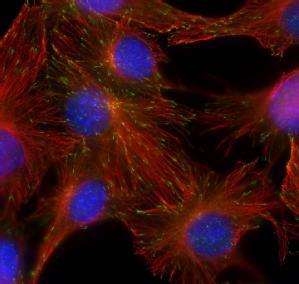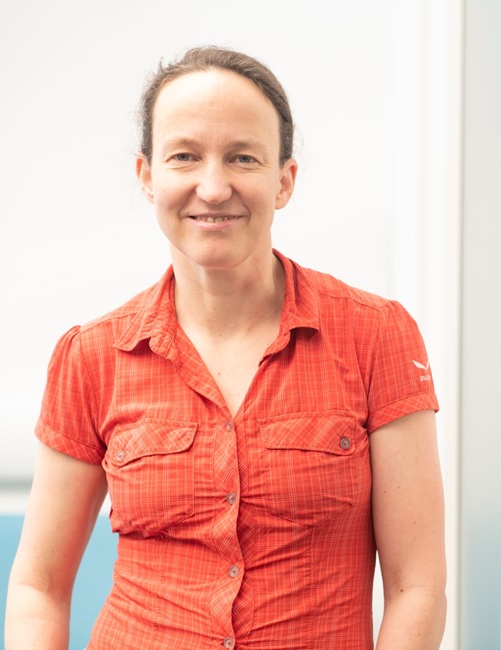Anne Straube
Technical Summary
Microtubules are essential for chromosome segregation, intracellular transport, positioning of organelles, directed cell migration and differentiation. All these processes require the organisation of microtubules into arrays with different geometry and density and the proper regulation of dynamics and interactions at the microtubule ends. My lab focuses on the mechanisms that generate specific microtubule arrays in polarised cells, the dynamic interactions of microtubule tips with intracellular structures and the cell cortex and the intracellular cargo transport along microtubules. To do this we combine quantitative live cell imaging approaches with in vitro reconstitution assays.
 Work in my laboratory has shown that KIF1C transports integrins into the cell rear, thereby enabling adhesion of cell tails and the generation of drag at the cell rear. This in turn contributes to directional cell migration (Developmental Cell 2012). Together with Andrew McAinsh and Jennifer Ross, we have shown both CLASP1 and uMAP4 prevent excessive dynein-driven astral microtubule movements and thereby ensure proper positioning of the mitotic spindle (Nature Cell Biology 2011). We identified a new isoform of MAP4, oMAP4 that organises the paraxial microtubule array in differentiating skeletal muscle cells by forming crosslinks between microtubules that resist motor forces (eLife 2015). In collaboration with Irina Kaverina, we have shown that CLASPs control both, the trafficking of the kinesin KIF1C (J Cell Science 2014) and the microtubule binding of EB proteins (Developmental Cell 2014). Recently, we have reconstituted the spatially distinct tip tracking of mammalian EB1, EB2 and EB3 and discovered that they recognise the nucleotide state of both tubulins surrounding their binding site (J Cell Science 2019). We also discovered the autoinhibition mechanism of KIF1C and identified two activators, the phosphatase PTPN21 and the cargo adapter HOOK3 (Nature Communications 2019).
Work in my laboratory has shown that KIF1C transports integrins into the cell rear, thereby enabling adhesion of cell tails and the generation of drag at the cell rear. This in turn contributes to directional cell migration (Developmental Cell 2012). Together with Andrew McAinsh and Jennifer Ross, we have shown both CLASP1 and uMAP4 prevent excessive dynein-driven astral microtubule movements and thereby ensure proper positioning of the mitotic spindle (Nature Cell Biology 2011). We identified a new isoform of MAP4, oMAP4 that organises the paraxial microtubule array in differentiating skeletal muscle cells by forming crosslinks between microtubules that resist motor forces (eLife 2015). In collaboration with Irina Kaverina, we have shown that CLASPs control both, the trafficking of the kinesin KIF1C (J Cell Science 2014) and the microtubule binding of EB proteins (Developmental Cell 2014). Recently, we have reconstituted the spatially distinct tip tracking of mammalian EB1, EB2 and EB3 and discovered that they recognise the nucleotide state of both tubulins surrounding their binding site (J Cell Science 2019). We also discovered the autoinhibition mechanism of KIF1C and identified two activators, the phosphatase PTPN21 and the cargo adapter HOOK3 (Nature Communications 2019).
Selected publications:
Siddiqui, N., Zwetsloot, A.J., Bachmann, A., Roth, D., Hussain, H., Brandt, J., Kaverina, Straube, A.* (2019) PTPN21 and Hook3 relieve KIF1C autoinhibition and activate intracellular transport. Nature Communications, Volume 10, Article number: 2693.
Roth, D., Fitton, B.P., Chmel, N., Wasiluk, N. and Straube, A. (2019) Spatial positioning of EB family proteins at microtubule tips involves distinct nucleotide-dependent binding properties. Journal of Cell Science 132, jcs219550.
Mogessie, B., Roth, D., Rahil, Z. and Straube, A.* (2015) A novel isoform of MAP4 organises the paraxial microtubule array required for muscle cell differentiation. eLife 4, e05697.
Theisen, U., Straube, E. and Straube, A.* (2012) Directional persistence of migrating cells requires Kif1C-mediated stabilisation of trailing adhesions. Developmental Cell 23, 1153-1166
Samora, C.P., Mogessie, B., Conway, L., Ross, J.L., Straube, A.* and McAinsh, A.D.* (2011). MAP4 and CLASP1 operate as a safety mechanism to maintain a stable spindle position in mitosis. Nature Cell Biology 13, 1040-1050.
Straube, A.* and Merdes A. (2007). EB3 regulates MT dynamics at the cell cortex and is required for myoblast elongation and fusion. Current Biology 17 (15), 1318-1325.

